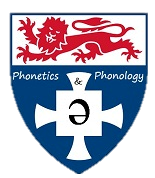-
News:
Accent Articulation Conference First Language Acquisition gamification Group focuses Job Laboratory Phonology Lecturer Linguistics Morphology Perception PhD Funding Phonetics Phonetics and Phonology Phonology Professor Project on Tyneside English Psycholinguistics R Research associate science open day Sociolinguistics Sociophonetics Speech Signal Analysis Speech signal processing statistics Workshop
Category Archives: Workshops
PoLaR Workshop with Byron Ahn: A Dive into Prosodic Analysis
On Tuesday, we were delighted to welcome Dr. Byron Ahn for an in-depth workshop on the use of PoLaR in analyzing prosodic features of speech. The three-hour session delved deep into the intricate layers of intonation. The workshop began by … Continue reading
Posted in Workshops
Tagged Accent, Laboratory Phonology, Phonetics and Phonology, Phonology
Leave a comment
Recent Workshop Recap
We are delighted to update our community on the successful completion of our recent workshop this Monday, titled “Training Your First ASR Model: An Introduction to ASR in Linguistic Research“. Workshop Overview:The workshop was designed to delve deep into the … Continue reading
Posted in Workshops
Tagged Accent, Phonetics, Phonetics and Phonology, Phonology, Sociophonetics
Leave a comment
Kaleidoscopic boundary tones
Date: 24/10/2022 Cong Zhang gave us a talk on boundary tones in Mandarin. Background information: Intonational tunes are generally made up of pitch accents and edge/boundary tones. The intonation in a tonal language is difficult to phonologise as F0 can … Continue reading
Phonetic discrimination ability of an English vowel contrast by German infants
Today, we have Hiromasa Kotera to present the preliminary work of his PhD study, which is about the retainability and sustainability of phonetic discrimination ability of infants. Rationale: The perceptual attunement effect has been hotly discussed in linguistics and child … Continue reading
Posted in Workshops
Leave a comment
Accent and Social Justice Workshop
Our research theme for 2021/22 has been “Accent and Social Justice”. We have read and reviewed literature on accent processing and perception, and discussed the prejudices towards certain accents and the injustices those may experience. In order to spread awareness … Continue reading
Posted in Workshops
Tagged Accent, Phonetics, Phonetics and Phonology, Phonology, Sociolinguistics, Sociophonetics
Leave a comment
Recap Semester 1 2021/2022
From September 2021 to February 2022, our research group has been very active and involved in several projects. Here is a short summary of what we discussed during our weekly meetings: Accent and Social Justice: Within our research theme for … Continue reading
Posted in Workshops
Tagged Accent, Phonetics and Phonology, Sociolinguistics, Sociophonetics, statistics
Leave a comment
Speech Signal Processing in R – student experience
Abdulrahman Dallak (IPhD Phonetics & Phonology) In this two-day workshop we covered some of the state-of-the-art techniques in processing and visualising acoustic and ultrasound data in R. Chris started the workshop talking about how he has been using these advanced … Continue reading
R Workshop on Speech Signal Analysis: Dr Chris Carignan #SpeechSignalR
updated 12 July 2021 We are very happy to announce that Dr Chris Carignan will be leading a workshop on speech signal analysis in R. The workshop will take place remotely via Zoom on 13th and 14th July 2021. Please … Continue reading
Introduction to Ultrasound Tongue Imaging
Training in the usage and analysis of UTI (Ultrasound Tongue Imaging) with Natasha Zharkova by Andreas Krug Over the course of two sessions, Natasha introduced us to the use of ultrasound tongue imaging in linguistics research. We learned about data … Continue reading

